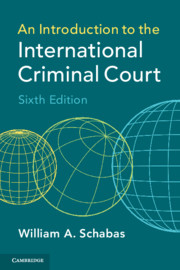Book contents
- An Introduction to the International Criminal Court
- An Introduction to the International Criminal Court
- Copyright page
- Contents
- Preface
- Abbreviations
- 1 Creation of the Court
- 2 The Court Becomes Operational
- 3 Jurisdiction
- 4 Triggering the Jurisdiction
- 5 Admissibility
- 6 General Principles of Criminal Law
- 7 Investigation and Pre-Trial Procedure
- 8 Trial and Appeal
- 9 Punishment
- 10 Victims of Crimes and Their Concerns
- 11 Structure and Administration of the Court
- Appendices
- Bibliography
- Index
11 - Structure and Administration of the Court
Published online by Cambridge University Press: 09 June 2020
- An Introduction to the International Criminal Court
- An Introduction to the International Criminal Court
- Copyright page
- Contents
- Preface
- Abbreviations
- 1 Creation of the Court
- 2 The Court Becomes Operational
- 3 Jurisdiction
- 4 Triggering the Jurisdiction
- 5 Admissibility
- 6 General Principles of Criminal Law
- 7 Investigation and Pre-Trial Procedure
- 8 Trial and Appeal
- 9 Punishment
- 10 Victims of Crimes and Their Concerns
- 11 Structure and Administration of the Court
- Appendices
- Bibliography
- Index
Summary
The International Criminal Court is a distinct international organization headquartered in The Hague. It works in close cooperation with the United Nations but is independent of it. The Court is composed of four ‘organs’: the Presidency, the Chambers, the Office of the Prosecutor and the Registry. The Presidency consists of the President and the two Vice-Presidents, who are elected by the Plenary of judges. Judges are elected by the Assembly of States Parties to terms of nine years; they must be nationals of a State Party. The judges are constituted into Divisions, for Appeals, Trials and Pre-Trial proceedings. Within each division may be one or more Chambers. The Appeals Chamber is generally composed of five judges while the other Chambers are generally made up of three judges, although a Single Judge may issue rulings in some cases. The head of the Office of the Prosecutor is the Prosecutor, who is elected to a nine-year term by the Assembly of States Parties. The Registrar is nominated by the judges but elected by the Assembly of States Parties and serves a term of five years. The Registrar is the principal administrative officer. The Court’s annual budget is proposed by its organs but must be confirmed by the Assembly of States Parties.
Keywords
- Type
- Chapter
- Information
- An Introduction to the International Criminal Court , pp. 380 - 420Publisher: Cambridge University PressPrint publication year: 2020



